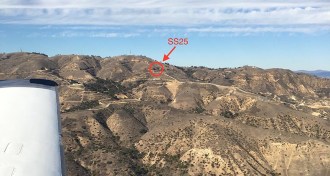Environment
-
 Environment
EnvironmentCalifornia gas leak spewed massive amounts of methane
New estimates suggest that a 2015 natural gas well blowout injected tons of greenhouse gases into the Los Angeles atmosphere.
-
 Oceans
OceansGulf oil spill could hasten corrosion of shipwrecks
Oil from the Deepwater Horizon disaster could hasten the corrosion of historical shipwrecks in the Gulf of Mexico, new studies of marine microbes suggest.
-
 Agriculture
AgricultureFDA to test foods for controversial herbicide
Amid controversy and conflicting studies, the FDA will test food for glyphosate, the most widely used herbicide in the world.
-
 Environment
EnvironmentVaping linked to host of new health risks
Animal studies and analyses of gene activity point to broad range of potential new health risks from vaping affecting everything from sperm to heart and immunity to mental health.
By Janet Raloff -
 Environment
EnvironmentUrban heat islands exist even in the Arctic
Arctic cities are a source of warming in the far north. Unlike midlatitude heat islands, poorly insulated buildings — not the sun — are a primary source.
By Janet Raloff -
 Earth
EarthOcean’s plastics offer a floating fortress to a mess of microbes
Microbes take up residence on ocean plastics, potentially causing changes in ocean environments.
-
 Environment
EnvironmentConverted milk proteins clean pollution, strike gold
A new membrane uses sticky amyloid proteins to trap contaminants in water.
-
 Agriculture
AgricultureJust adding pollinators could boost small-farm yields
Adding pollinators could start closing gap in yields for small farms.
By Susan Milius -
 Animals
AnimalsWhales are full of toxic chemicals
For decades, scientists have been finding troublesome levels of PCBs, mercury and other toxic chemicals in whales and dolphins.
-
 Environment
EnvironmentPCB levels still high in Europe’s killer whales, smaller dolphins
PCBs banned for decades still show up at extremely high concentrations in Europe’s killer whales and other dolphins.
By Susan Milius -
 Animals
AnimalsFog ferries mercury from the ocean to land animals
Scientists have traced mercury in the waters of the Pacific Ocean to animals, including mountain lions, in California.
-
 Climate
ClimateFireworks brighten the sky but dampen the view
Fireworks and other pyrotechnics severely reduce visibility during celebrations such as New Year’s Eve and Guy Fawkes Day, researchers report.